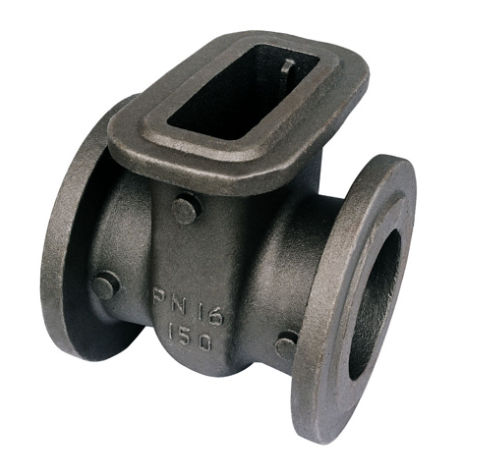Carbon black defects and preventive measures for ductile iron castings made of lost foam
1. Formation mechanism
Polystyrene foam plastics first melt into liquid polystyrene under the heat of high-temperature molten metal, and then the liquid polystyrene is cracked into liquid polymers, whose main components are styrene, benzene, etc., and further cracked into small molecular gaseous compounds under the heat. During the casting process, these products must escape from the cavity through the coating. The liquid product first wets the coating, spreads on the surface of the coating, and then penetrates the capillary pores of the coating. Under the action of vacuum negative pressure and static pressure of the metal liquid, the penetration effect is enhanced. Due to the fast filling speed of the molten metal, the liquid pyrolysis products do not have time to fully crack and gasify, and solid carbon black is generated under high temperature and oxygen-deficient conditions. Studies have shown that the high carbon content in cast iron is the direct cause of carbon black, and the wettability of liquid polystyrene to the coating is the main reason for the formation of carbon black.
2. Influencing factors and corresponding preventive measures for carbon black defects
2.1 The influence of refractory fillers in coatings on the formation of carbon black: The type, particle shape, particle size and distribution of refractory fillers will affect the wettability of liquid polystyrene to the coating. The wettability of liquid polystyrene to bauxite coatings is better than that to silica powder and talcum powder coatings, which is mainly determined by the structural characteristics and surface physical properties of refractory fillers. Bauxite particles are relatively round, with large stacking pores and porous structural characteristics. The exposed micropores can achieve capillary siphoning of liquids, enhancing the wettability of liquids to it; while silica powder particles are polygonal, and the particles are stacked and interlaced, making their pores smaller, thereby reducing the capillary siphoning effect on liquid products.
2.2 The influence of binders on the formation of carbon black: The organic binder in the coating melts almost simultaneously with the polystyrene foam under the heat of the high-temperature metal liquid. If the organic binder has an affinity with liquid polystyrene, it is beneficial for the liquid polystyrene to wet and penetrate the coating. At the same time, the organic binder is vaporized under the action of high-temperature molten metal, which increases the pores between the refractory fillers, improves the permeability of the liquid product, and allows the liquid polystyrene to escape from the coating quickly, and less carbon black is produced on the surface of the casting.
2.3 Effect of high-temperature air permeability of the coating on the formation of carbon black: Practice has proved that the high-temperature air permeability of the coating has an important influence on the formation of carbon black. The higher the air permeability of the coating, the larger the pores between the particles, which is beneficial for the rapid escape of liquid polystyrene and its cracking products, and less carbon black is produced on the surface of the casting.
2.4 Effect of foam plastic pattern materials on carbon black formation: Relevant literature points out that different pattern materials have different pyrolysis mechanisms and produce different pyrolysis products. From the composition of the pattern material, the ratio of carbon to hydrogen atoms in the EPMMA molecule is 5:8, and the weight ratio is 60:8; while the ratio of carbon to hydrogen atoms in EPS is 8:8, and the weight ratio is 92:8. Therefore, it can be seen that EPMMA has a low carbon content, and the carbonaceous residue obtained by cracking is only 5/8 of EPS. Therefore, the use of EPMMA material produces less carbon black, which can reduce the formation of carbon black in ductile iron castings.





